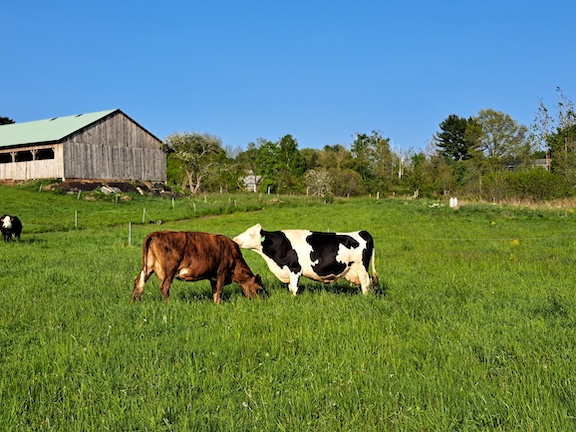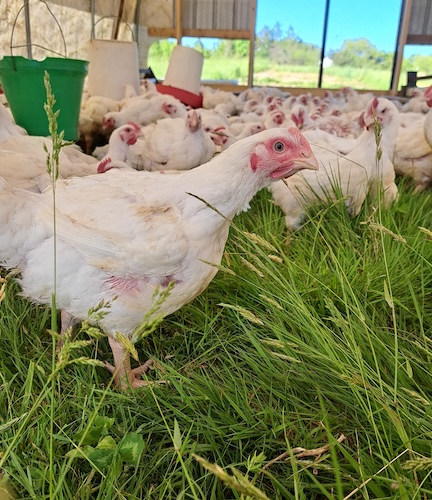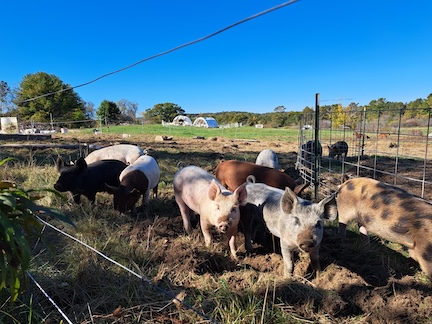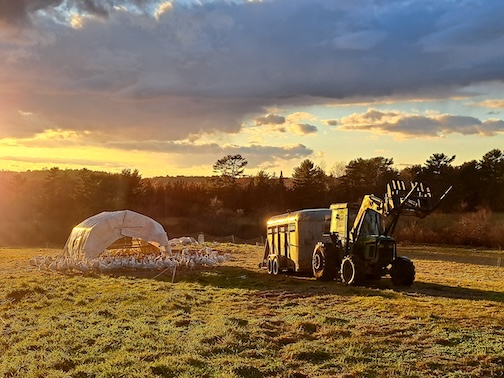By Sonja Heyck-Merlin
Farmers Rhiannon Hampson and Gregg Stiner joined the longstanding agricultural tradition of Thomaston, Maine, in 2018 when they closed on their 80-acre farm off coastal Route 1, close to the St. George River. They were told that the site of what is now their Grace Pond Farm has been farmed since the 1600s, adding that the town historian said that at one point it was part of the town farm. “But,” Hampson says, “when we bought the farm it had been dormant for decades, other than some hay being made. There was a lot of clean-up to do. Most people wouldn’t have bought a livestock farm with no infrastructure.”
Some people would also have shied away from its proximity to a housing development, but the price was right, and they were optimistic about the land’s potential to produce organic milk and pasture-raised proteins for direct markets.
As organic farmers, they assessed the available natural and man-made resources — topography, soil, rocks, trees, water, buildings, and roads — and considered how to conserve these resources while being agriculturally and economically productive.

Regarding the man-made resources, the decisions were quite obvious. Other than their house, built in 1781, there was no usable infrastructure. Even the house, they plan to eventually tear down. Over the past few years, the couple has removed about seven decrepit outbuildings and their contents, filling dozens of 30-yard dumpsters with trash.
Since Stiner and Hampson already owned dairy cattle, having grown a small herd while farming at two other Maine organic dairies, one of their first priorities was to build livestock infrastructure. They put up a 30-by-40-foot multi-use building, which serves as their milking parlor, milk room, and farm store, and a 44-by-80-foot bedded pack barn. The bedded pack barn has two attached high-use areas — easily cleanable concrete surfaces used to feed and keep livestock during the non-grazing months. They also recently completed a third building that serves as their poultry brooder. Eventually, they will relocate their farm store to this building.
Getting water to their livestock was also an early priority, so they built an above-ground pasture water system. They also built a lane to the farthest reaches of their pastures and improved others because having mud-free lanes is important for helping to keep the dairy herd clean. Stiner and Hampson sell raw milk, so keeping hooves, legs, and udders manure-free helps ensure that they meet the state’s standards, which include frequent bacterial testing.
Their 30-acre pasture system, surrounded by a single strand of high-tensile steel fencing, is one of their primary natural resources. Above all else, Stiner considers himself to be a grass farmer, using a diversity of livestock species to transform the grass into high-quality proteins. The soil is mostly clay and fairly heavy, more suited to grazing than cropping. Hampson says, “We’d be sad if we were veggie farmers.”
The total herd is about 30 cows. The farmers breed the cows to calve in the spring, so that the herd is at the tail of their lactation in the late winter when the demand for milk is lowest. Since the herd is synched to be dry (not lactating) at the same time (the cycle is 10 months in milk, two months dry), they transition to once-a-day milking in February and March.

Most of the year, they are milking about 18 cows, primarily Jerseys with some Normande and Guernsey genetics incorporated through artificial insemination. The remainder of the herd consists of replacement heifers, young calves, and a few steers raised for beef. The milk cows are rotationally grazed through small paddocks divided by a single strand of polywire, and are turned onto a new paddock after morning and evening milkings. Heifers and dry cows are rotationally grazed in their own rotation on leased acreage.
Grace Pond Farm’s resource of ample grass also helps to raise 4,000-5,000 Cornish Cross broiler chickens each year. “The broilers do a good job foraging, getting bugs, and eating quite a bit of grass. They also put down a mat of manure,” Stiner says. Though the broilers do consume grass, their primary feed is a mix of Maine-grown, non-GMO grains.
The day-old broilers, which come in multiple batches throughout the pasture season, are raised for about three and a half weeks in the poultry brooder building. Then, they are transitioned into homemade 14-by-30-foot houses that get moved daily onto a new section of pasture.
Since their pasture system is separated by naturally-formed small ravines — low points where water runoff flows gradually — each year they choose a 6-acre parcel to accommodate the poultry rotation. The cows continue to graze this parcel; it’s not uncommon to see a single strand of polywire surrounding the poultry houses with cows just on the other side of the fence.
The land also supports 80 pigs, purchased as piglets annually, that utilize the farm’s overgrown field edges of non-native species and scrub alders. Like the broilers, the pigs consume some forage but also receive a grain ration.
“The pigs have been instrumental in helping us clear out the farm road, and they have helped us open up a lot of land. Pigs can take any topsoil away pretty quickly. You really have to watch that, but if you keep them moving, they can really do a lot of good,” Stiner says.
Raised in groups of 10, the pigs are rotated through a 2 ½-acre section of field edge divided into smaller sections with two strands of electric fence. In 2018, the farmers started spreading dairy manure on the pig ground and then running over it with a set of discs. They then seeded with annuals like winter wheat, rye, and oats along with perennial red clover. In the fall of 2024, they added some Italian ryegrass to the mix. These reclamation projects have been successful in increasing their pasture acreage.

Each year they also pasture 500 turkeys, which are raised primarily for the Thanksgiving market. Like the broilers, the turkeys move within the milkers’ pasture system, but they’re contained by portable electric netting. A homemade hoop structure provides housing, shade, and access to their grain ration and water.
The resource management shifts significantly as the poultry, turkeys, and pigs are slaughtered in the late fall, and the cows are transitioned to the bedded pack barn.
This barn has a gravel base and serves as a large loafing area for the cows, with corral panel pens set up for heifers younger than six months. They use dry sawdust and shavings for bedding, which is stirred every other day with the long tines of a three-point-hitch box scraper.
Other than the 5 pounds of organic grain that the milk cows get while they’re in the milking parlor and a few pounds of grain per day for the weanlings, the cows eat round bales of purchased organic baleage. They feed about 300 bales during the non-grazing season.
The pack barn is cleaned out twice a year, and the mix of bedding and manure is spread on the farm’s reclamation areas. The couple also recently spread the material on a 24-acre underproductive hay field that they are leasing with a neighbor.
Soon, however, with the financial support of a Natural Resources Conservation Service Environmental Quality Incentives Program (NRCS EQIP) grant (whose funding has also helped build their high-use areas, lanes, and pasture water system), they will gain a covered manure storage area where they plan to compost the bedded pack material. Ideally, they would like to produce a community resource — bagged certified organic compost for their neighbors’ gardens — and create an additional revenue stream.
“Being a dairy, we make so much more manure than we possibly need to spread on the fields. Because of the poultry, our fields are not in as desperate need as they would be somewhere else. It’s going to potentially be an additional income stream because we have that bedded pack barn and all of the fertility that comes out of there,” Stiner says.

The cows transform grass not only into valuable manure but also nutritious organic milk that flows from their four-cow milking parlor into an 800-gallon bulk cooling tank. From the bulk tank, the milk is transferred into plastic and glass containers that are sold at their farm store and several retail locations.
About half of their total milk production goes to three value-added cheese and yogurt producers. Stiner delivers milk to Fuzzy Udder Creamery in a 215-gallon bulk tank in a modified horse trailer. The other two producers — Copper Tail Farm and York Hill Farm — pick up their milk. “Our milk has helped win the Maine Cheese Festival’s ‘Best in Show’ for multiple years,” says Hampson.
It wasn’t their intention to purchase a property so close to Route 1, but when they decided to, it became obvious that they should take advantage of the busy road as a resource. They established a farm stand. They move about 50% of their milk and 50% of their pork, chicken, and beef through the store with the only advertising being a hand-painted pallet at the driveway’s end. They also sell some other farm products, including cheeses and yogurt from their three wholesale milk buyers.
Stiner recalled an early morning shopper on Christmas Day as he was headed out at 4:30 a.m. for milking. The customer desperately needed some bacon for breakfast and knew the Grace Pond Farm store would be open.
Their customers value not only the products but the experience the farm provides. “It’s just a very authentic experience. It’s safe because it’s down our long driveway and not on the side of the road. Customers can go in and get chicken, milk, and whatever they need,” says Hampson.
Managing these resources — their growing infrastructure plus the soil, pastures, livestock, and forests — does come with challenges. Cows must be milked, snow must be removed for those committed customers, livestock must be hauled to the slaughterhouse. The list really never ends. Dairy farming, in particular, is relentless.
When it comes time to attend their children’s school events, Stiner and Hampson typically drive separately so that Stiner can finish evening chores and slip in at the last moment. The family doesn’t go to Puerto Rico for the holidays like some of their kids’ schoolmates do. In fact, they really don’t go on family vacations. Hampson juggles full-time, off-farm, and often demanding public-facing jobs with her farm roles. She recently transitioned from a position as the state director for Maine with United States Department of Agriculture (USDA) Rural Development with the Biden-Harris administration to vice-president of economic development at the Gulf of Maine Research Institute.
Though the tradeoffs are worth it to Stiner and Hampson: They’re proud to be part of the Thomaston community and are grateful to nurture these resources, and to work with this land in a way that they hope leaves it better for their having farmed there.
“When you think about the legacy of going on family vacations all the time versus the legacy of having had this dairy and livestock farm for a generation, what’s the legacy that you want to leave? Right now, this is the one we have agreed to,” says Hampson.
Stiner adds, “Our customers have a vested interest in the farm in terms of feeling as though they belong here, and the farm belongs. We want people to think of the farm as a community resource.”
Sonja Heyck-Merlin is a regular feature writer for The MOF&G. She and her family own and operate an organic farm in Charleston, Maine.
This article was originally published in the summer 2025 issue of The Maine Organic Farmer & Gardener.